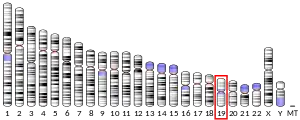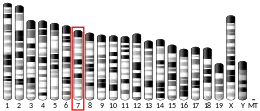NTN5
Netrin-5 (NTN5), also known as netrin-1-like protein, is a protein that in humans is encoded by the NTN5 gene.[5] Netrin-5 is included in the family of secreted laminin-related proteins.
| NTN5 | |||||||||||||||||||||||||||||||||||||||||||||||||||
|---|---|---|---|---|---|---|---|---|---|---|---|---|---|---|---|---|---|---|---|---|---|---|---|---|---|---|---|---|---|---|---|---|---|---|---|---|---|---|---|---|---|---|---|---|---|---|---|---|---|---|---|
| |||||||||||||||||||||||||||||||||||||||||||||||||||
| Identifiers | |||||||||||||||||||||||||||||||||||||||||||||||||||
| Aliases | NTN5, netrin 5 | ||||||||||||||||||||||||||||||||||||||||||||||||||
| External IDs | MGI: 2685330 HomoloGene: 17106 GeneCards: NTN5 | ||||||||||||||||||||||||||||||||||||||||||||||||||
| |||||||||||||||||||||||||||||||||||||||||||||||||||
| |||||||||||||||||||||||||||||||||||||||||||||||||||
| |||||||||||||||||||||||||||||||||||||||||||||||||||
| |||||||||||||||||||||||||||||||||||||||||||||||||||
| Wikidata | |||||||||||||||||||||||||||||||||||||||||||||||||||
| |||||||||||||||||||||||||||||||||||||||||||||||||||
Function
Netrin-5 functions are not fully clarified. However, it is believed to:
- Plays an important role in neurogenesis by controlling the development of dendrites and acting as a guide for axons.[6][7]
- Regulates cell migration in the brain during embryonic development.[8]
- Prevents motor neuron cell body migration out of the neural tube.[8]
Clinical significance
A recent genome-wide association study (GWAS) has found that genetic variations in HAVCR2 are associated with late-onset sporadic Alzheimer’s disease (LOAD). However, it's unknown how netrin-5 mutation contributes to disease.[9]
Considering the role of NTN5 in cell migration, it is very possible that netrin-5 has an important role in human carcinogenesis, although currently no tumor type with NTN5 alterations has been identified.[10]
References
- GRCh38: Ensembl release 89: ENSG00000142233 - Ensembl, May 2017
- GRCm38: Ensembl release 89: ENSMUSG00000070564 - Ensembl, May 2017
- "Human PubMed Reference:". National Center for Biotechnology Information, U.S. National Library of Medicine.
- "Mouse PubMed Reference:". National Center for Biotechnology Information, U.S. National Library of Medicine.
- "NTN5 netrin 5 [Homo sapiens (human)] - Gene - NCBI". www.ncbi.nlm.nih.gov. Retrieved 2021-12-11.
- Yamagishi S, Yamada K, Sawada M, Nakano S, Mori N, Sawamoto K, Sato K (2015). "Netrin-5 is highly expressed in neurogenic regions of the adult brain". Frontiers in Cellular Neuroscience. 9: 146. doi:10.3389/fncel.2015.00146. PMC 4403520. PMID 25941474.
- Ikegaya S, Iga Y, Mikawa S, Zhou L, Abe M, Sakimura K, et al. (2020). "Decreased Proliferation in the Neurogenic Niche, Disorganized Neuroblast Migration, and Increased Oligodendrogenesis in Adult Netrin-5-Deficient Mice". Frontiers in Neuroscience. 14: 570974. doi:10.3389/fnins.2020.570974. PMC 7726356. PMID 33324143.
- Gaudet P, Livstone MS, Lewis SE, Thomas PD (September 2011). "Phylogenetic-based propagation of functional annotations within the Gene Ontology consortium". Briefings in Bioinformatics. 12 (5): 449–462. doi:10.1093/bib/bbr042. PMC 3178059. PMID 21873635.
- Wightman DP, Jansen IE, Savage JE, Shadrin AA, Bahrami S, Holland D, et al. (September 2021). "A genome-wide association study with 1,126,563 individuals identifies new risk loci for Alzheimer's disease". Nature Genetics. 53 (9): 1276–1282. doi:10.1038/s41588-021-00921-z. hdl:1871.1/61f01aa9-6dc7-4213-be2a-d3fe622db488. PMID 34493870. S2CID 237442349.
- Bruikman CS, Zhang H, Kemper AM, van Gils JM (2019-02-24). "Netrin Family: Role for Protein Isoforms in Cancer". Journal of Nucleic Acids. 2019: 3947123. doi:10.1155/2019/3947123. PMC 6408995. PMID 30923634.
This article is issued from Wikipedia. The text is licensed under Creative Commons - Attribution - Sharealike. Additional terms may apply for the media files.



